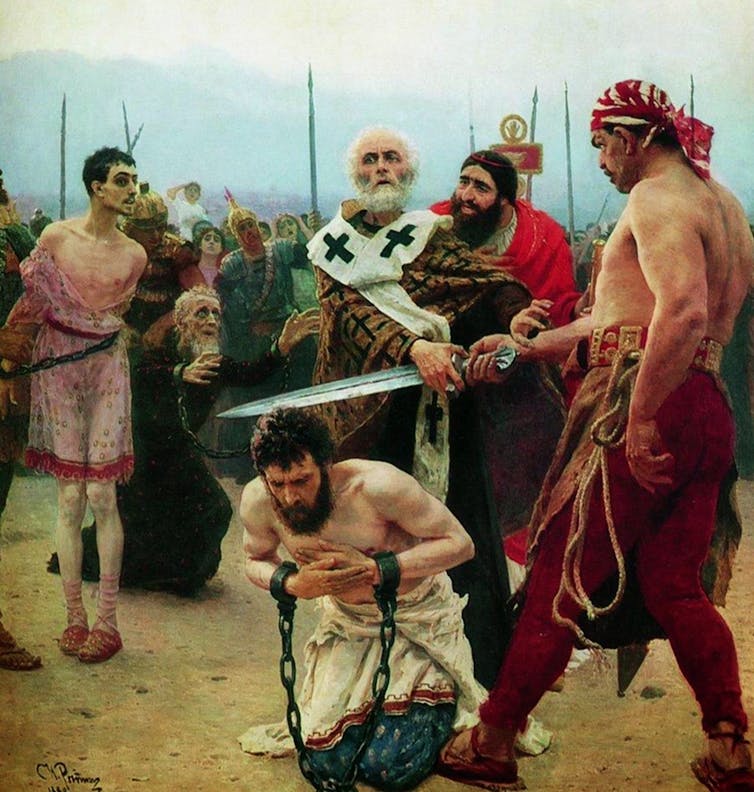
Santa Claus is based on the real historical figure of St Nicholas, a Byzantine bishop born in present-day Turkey. Because of the extraordinary legends and miracles attributed to him he became one of the most popular saints in Europe.
Dutch migrants probably spread his fame to the US and there the patron saint of children was transformed through books, magazines and films into the familiar Santa Claus, or Father Christmas, figure we know today.
There is the story about St Nicholas that everyone knows – the one about him giving gifts to the poor in the dead of night – the Santa Claus origin story. But there’s another story that is probably less familiar to most of us.
It’s a story about how Nicholas fought against a miscarriage of justice. The story begins when a local businessman goes to see the provincial governor. For reasons that are lost to history, he wants three innocent men, Nepotian, Ursyna and Apollyn, killed. The governor, a notoriously dishonest man called Eustathios, is only too happy to help.
The earliest writing on the life of Nicholas is to be found in the Bibliotheca Hagiographica Graeca, and believed to be written in the first half of the 9th century by Michael the Archimandrite. It suggests that once the bribe had been paid, the men were condemned to death.
Word of what was happening reached Nicholas and he raced to the square. Just as the executioner raised his sword to dispatch the first prisoner, Nicholas threw himself between the executioner and the condemned man. Grabbing the executioner’s arm, he ripped the sword away, untied the innocent men and set them free.

He then admonished the governor. When faced with the righteous fury of Nicholas, Eustathios fell to his knees and repented, promising to change his ways, sources suggest.
This is a very different image of St Nicholas than most people are used to in the 21st century. This is not the kind and humble 4th Century bishop, the proto-Santa Claus. Instead, this is the action hero, the St Nicholas who is not afraid to face down an executioner’s sword.
As bishop of Myra – a coastal town in what is now Turkey – St Nicholas was a leading Christian figure in an empire that was growing more and more concerned about the increasing power of Christianity.
The Roman emperor Diocletian decided it was time to send out a message. He ordered the torture of any Christian who refused to worship the Roman gods. It unleashed a reign of terror. Nicholas was one of those imprisoned and tortured. The persecution by Diocletian lasted between eight and ten years.
When Bishop Nicholas was finally freed, he was a changed man. Putting his life on the line for people he had never met could have been simply because he knew what it felt like to be innocent and have your freedom taken away.
And so while the story of St Nicholas secretly handing out bags of gold to a poor family should be remembered and eventually become the inspiration for the jolly, rosy-cheeked figure of Santa Claus, there are other aspects to this character.

Nicholas was a wealthy man and so when he gave away his gold it was an act of kindness but nothing that he could not afford. That he chose to do so anonymously showed his humility. These were the acts of a compassionate bishop, of a man who would soon become celebrated, then famous and eventually a saint.
And as the centuries passed, the legend of St Nicholas would grow and grow – as would the powers attributed to him. From controlling the weather to appearing to Roman emperors in dreams, there seemed to be little that St Nicholas could not do.
He became the patron saint of children, pawnbrokers, unmarried women, sailors, repentant criminals, students, business people and countless European cities. And of course eventually he would become reimagined as Santa Claus.
But there is something about the story of the rescue of the three innocent men and Nicholas’s fight for justice that stand out against all the embellishments, the Christmas films and the myths. It’s a tale that shows how and why the legend of Nicholas spread across the world.
Brian Thornton, Senior Lecturer in Journalism, University of Winchester
This article was first published on The Conversation, a global media resource that provides cutting edge ideas and people who know what they are talking about.






















